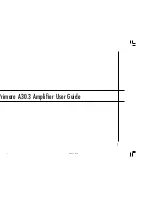
6
9. LINE
GAIN
This Gain control varies the gain of the Line input. The gain ranges from Off, 0 dB (center
detent), to +10 dB.
10. LOW
EQ
A shelving type of active tone control that varies the frequency range below 80 Hz by +/-15 dB.
11. LOW
MID
A band pass (boost/cut) type of active tone control that varies the signals within the selected
low-frequency range with +/-15 dB.
12.
(LOW MID) FREQUENCY
This control determines the center frequency of the Low Mid EQ which varies between
100 Hz and 3 kHz.
13.
(LOW MID) BANDWIDTH
This control changes the bandwidth (Q) of the bell-shaped curve of the Low Mid EQ. The BW
ranges from 2 to 1/5 oct.
14. HI
MID
A band pass (boost/cut) type of active tone control that varies the signals within the selected
hi-frequency range with +/-15 dB.
15.
(HI MID) FREQUENCY
This control determines the center frequency of the Low Mid EQ which varies between
500 Hz and 15 kHz.
16.
(HI MID) BANDWIDTH
This control changes the bandwidth (Q) of the bell-shaped curve of the Low Mid EQ. The BW
ranges from 2 to 1/5 oct.
17. HIGH
EQ
A shelving type of active tone control that varies the frequency range above 12.5 kHz
by +/-15 dB.
18. LEVEL
This level control (ranges from –97 to +6 dB) sets the level sent to the direct channel output
and to the A and B summing outputs through the Pan control. The reference level for this
control is 0 dB (center detent) – unity gain.
19. PAN
Sets the channel signal in A or B summing outputs and is inactive when the Mono switch (25)
is depressed.
20. SMARTUBE
™
This control mixes the signal after the tube-sound processor circuit with the clean channel
signal and ranges from “clean” (Off) to “all-tube-sound” (Max). It uses solid-state technology
and replicates the characteristics and sound quality of a microphone tube amplifier by
introducing the spectral and harmonic structure typical for a tube stage.


































